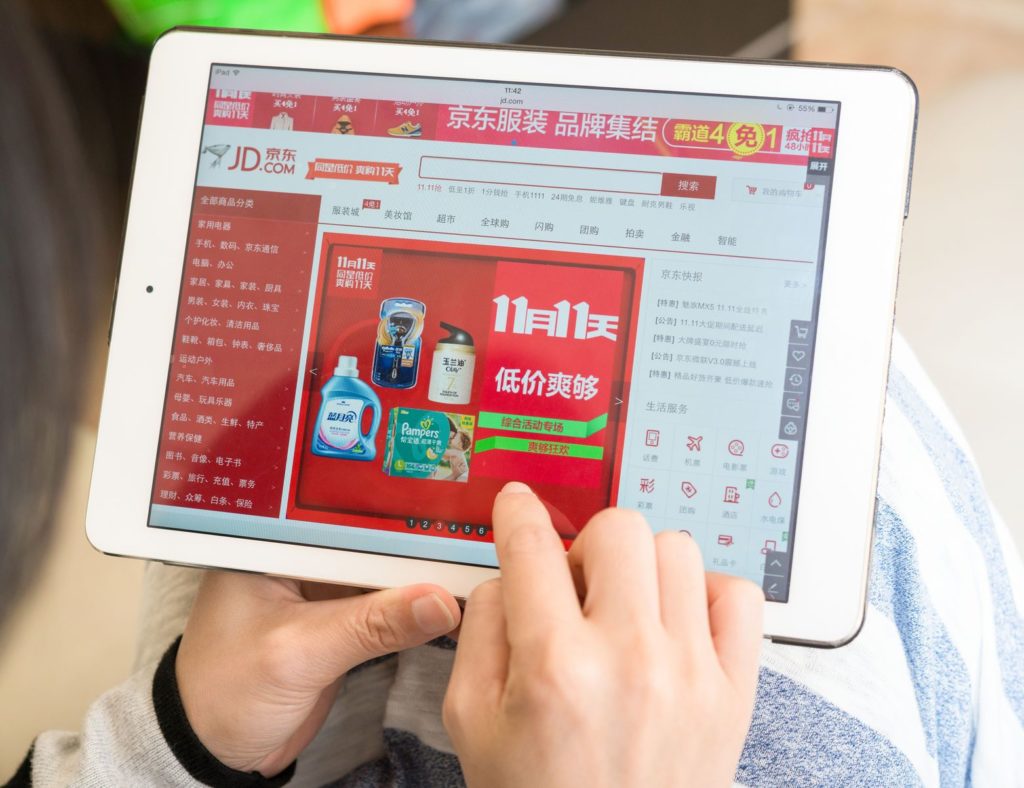In China, luxury products are rarely bought in the store or on the website of the brand itself but on platforms like Alibaba and JD.com. The latter, originating from Beijing, has more than one ace up its sleeve. We breakdown this perfectly calibrated phenomenon with Altavia Global Key Account Director, Stéphane Joly.
“JD.com, the largest retailer in China”
It is the 2nd largest e-commerce platform behind Alibaba. The figures presented at the conference given by Kevin Jiang, Vice-President of International Business at JD.com, confirm that the platform is now a key player.
Let’s take a quick look at the figures:
- Over 300 million active users, i.e. up 30% compared to 2017.
- Turnover in excess of $200 billion (value of the products that pass through the platform) at the end of 2018, i.e. up 150% compared to the previous year.
- A $67 billion profit, i.e. +200% in one year for a stock market valuation of $46 billion.
- “JD.com sees itself as the largest retailer in China and the world’s 3rd Internet company, behind Google and Amazon” explains Stéphane Joly.
A major platform
JD. com alone works with 160,000 traders. It sells electronics, fresh produce, consumer goods, textiles, Hi-Fi equipment, furniture and decoration… as well as luxury products.
“According to Kevin Jiang, platforms have become search engines: 37% of users use the site to look for products and 42% for inspiration” explains Stéphane Joly.
The advantages of JD.com
Although the Beijing-based platform remains behind Alibaba with its two platforms Alibaba, Taobao and Tmall that account for 600 million active users, it has nevertheless set itself apart in more than one area. “JD.com has decided to join forces with Tencent, whose messaging app WeChat is the largest social network in China, with 1 billion active users. This partnership is highly strategic as it allows the platform to collect a vast amount of data and thus optimise the targeting of its communication to users. Alibaba, for its part, does not use any social networks”. JD.com has also partnered with the search engine Baidu and Toutiao, a news and video content platform. “A highly intelligent positioning, that allows JD.com to collect information on products likely to interest its customers” adds Stéphane Joly.
Another advantage: counterfeit control. JD.com applies a strict policy that gets results – unlike Alibaba, which suffers from its lack of reliability in this area.
JD.com is also backed by excellent logistics. 90% of the articles available can be delivered in 24 hours within China. A VIP delivery system is also available, allowing young women, for example, to have their order delivered by handsome young men wearing white gloves…
JD Luxury
In China, luxury products are rarely bought in the store or on the website of the brand itself but on platforms like JD.com, which has launched JD Luxury.
Who are the website’s clients? According to Kevin Jiang, 74% are aged between 26 and 45 and 60% come from big cities.
“The website has great ergonomics and all the codes associated with brands are respected”, says Stéphane Joly. “A large number of prestigious brands, like Paul Smith, Prada, Tod’s, Escada, Fred, Versace, etc. have opened a boutique in their name. Delivery is handled by the platform”. The return rate, between 15% and 20%, is well below that of other Chinese websites; proof of the efficiency of its data collection, made possible in particular thanks to its partnership with Tencent.
“It appears that Chinese consumers of luxury products are becoming less and less accustomed to receiving deliveries from abroad”, reveals Stéphane Joly. The difference in the sales price between those applied in China and those in the country of origin is narrowing. The new anti #代购 (Daigou) laws – intermediaries that buy luxury articles abroad for a third party and take them through customs on their return to China without paying the import taxes – mean that 22% of purchases of luxury articles are made in China, compared to 8% previously.”
JD is able to target the ‘generation self’ which is creating its own fashion
Just a few years ago, Chinese consumers only bought brands (and often the same ones). Nowadays they are less followers and much more interested in design.
“Chinese consumers of the “generation self” are part of the 2nd generation of only children – the first without cousins,” explains Stéphane Joly. “They are very egocentric, curious, and confident of their ability to create their own fashion, on the hunt for a niche design product.” A real challenge for luxury brands, which can no longer predict what these consumers will buy. “We talk about Audience X to refer to the fact that with ultra personalisation, it is difficult to known what will be a success.” But the good news is that access to luxury products in mid-size and secondary Chinese cities means that growth for these brands is phenomenal.
The influence of key opinion leaders
Although the Chinese are confident of their ability to create their own fashion, they also follow the opinion of influencers on social networks. “Social commerce, linked to interaction between social media and the power of influencers, is highly developed in China”, notes Stéphane Joly. “In a short space of time, a brand can therefore skyrocket… or plummet! That was the case of Dolce&Gabbana at the end of 2018, which still has not recovered.”
An inescapable phenomenon that luxury brands must also incorporate into their strategy. As such, JD.com has been able to position itself, within 5 years, as the key intermediary in the quest to conquer this flourishing market

